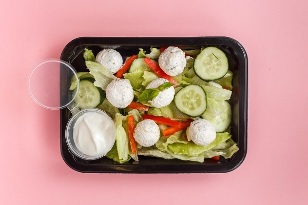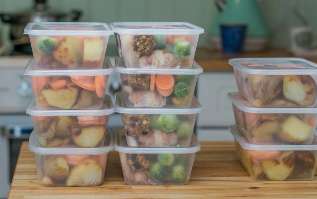What is a healthy diet plan for weight loss like? What types of food should be excluded from the diet for PP, how much protein, carbohydrates and fat should you eat each day?
Healthy eating basics and rules

For optimal results, especially if you are just starting out with a healthy lifestyle, you can follow the MyPlate method. This means that you divide each food into 5 food groups. Read further.
Protein
Ideally, protein makes up about 20 percent of your total daily calories.
How much protein should you eat?
You should be consuming about 0. 8 to 1. 2 grams of protein for every kilogram of your body weight per day. You should try to divide this amount across all meals and snacks throughout the day, rather than converting it to one or two meals. Protein is very important if you are trying to lose weight by burning fat on your body. The fact is that it takes more energy to break down and assimilate protein than other macronutrients, resulting in higher calorie expenditure.
Cereals
Cereals often have a bad reputation because most grain foods today are industrially processed into fast carbohydrates such as sweet cereals and white bread. If you choose unprocessed whole grains and grains, you will immediately receive all the benefits of cereal: energy, vitamins and minerals necessary for the normal functioning of the body.
How much cereal do you need?
You need about six servings of cereal or 170 grams per day. A slice of bread and half a cup of rice or pasta count as one serving. At least half of your serving should be whole grains.
Fruit
What else you need to include in your diet to lose weight? Fruit. Even the fact that fruits contain sugar, especially fructose, is okay if you don't exceed your daily calorie intake. Your body needs fructose to stay healthy. As such, fruits are naturally sweet, which means they can satisfy your sugar cravings if you don't feel like eating chocolate at night.
How many pieces do you need?
You should consume about two servings a day. Whole apples, oranges, or bananas count as one serving.
Which fruit should you choose?
You should eat mostly fresh fruit and limit your intake of fruit juices and processed foods like applesauce, for example (unless you make your own).
Vegetables
If you really want to know the right way to eat to lose weight, just remember vegetables - your new best friend. They are rich in fiber, which is beneficial for your digestive system. They're also low in calories and full, so you can eat more vegetables than other foods and consume fewer calories at the same time, which ultimately leads to quality weight loss.
How many vegetables should you eat?
You will need three to four servings.
Which vegetables to choose?
Try to eat lots of dark green leafy vegetables such as spinach, kale, broccoli and asparagus. Starchy vegetables like potatoes are also beneficial. Cooking vegetables (not boiling as this removes all of the nutrients) is one way to enhance the taste if you don't like eating them raw.
Dairy products
We consume dairy products because of their high vitamin and mineral content. They are high-protein foods, so a snack like cottage cheese is ideal if you need to eat something before your next full meal. Since dairy products are generally great sources of protein, they are also part of a weight loss package.
How much dairy do you need?
Roughly speaking, you need about three servings of dairy a day. One cup of milk or yogurt counts as one serving.
What if you can't / don't want to consume dairy products?
It's not the dairy product itself, but the nutrients that are essential to a healthy diet. So, if you can't eat dairy due to an allergy or lactose intolerance, or you don't like it, there are other potential ways to get these essential vitamins and minerals and still get great results.
- Broccoli, cabbage, figs and oranges are rich in calcium.
- Dark green leafy vegetables (cabbage, broccoli), tomatoes and citrus fruits contain vitamin C.
- Minerals such as phosphorus, magnesium, and iron are found in many other foods that you have eaten.
- You can also take a daily multivitamin to fill all those micronutrient gaps.
What about fat?
Fats and oils are no longer technically separate food groups. When dieting, you tend to automatically consume the fat you need to stay healthy.
And where do I get my fat?
If you eat a wide variety of healthy foods, you should get all the healthy fats you need. But no more than 30 percent of your daily calories should come from fat.
The Truth About Carbohydrates
You've probably heard that not all carbohydrates (sugars) are bad. When you see experts talking about how bad sugar is for you, they are usually talking about added sugar. Such sugars are added to our food during processing for a number of reasons and should be limited, if not excluded.
However, carbohydrates found in whole grains, fruits, vegetables and dairy products are harmless in moderation. You shouldn't be intimidated by this type of sugar. In your body, it turns into the energy you need to stay healthy.
How many calories should I consume per day?

Now that you know how to eat well for weight loss, you may still be wondering how many calories you can eat per day. Technically, you don't have to count calories if you don't want to. The standard for men and women is 2000 kcal. You can calculate your calorie needs if you really want to know and track them on a daily basis, but it all depends on what you eat and how active you are. Instead, pay attention to the type of food and portion sizes, as this can be a much more effective but less difficult way to achieve results.
Calculation of daily calorie intake for weight loss
To find out how many calories you need per day, you can use one of the calorie calculation formulas. The most commonly used formula is Tom Venut. It looks like this:
Male: 66 + (13. 7 x body weight) + (5 x height in cm) - (6. 8 x age in years)
Female: 665 + (9. 6 x body weight) + (1. 8 x height in cm) - (4. 7 x age in years)
The resulting number is multiplied by the coefficient of physical activity:
- Sedentary work, sedentary lifestyle: 1. 2
- Average stress level (morning exercise 3 times a week) 1. 38
- Heavy load1. 56
- The load is very heavy1, 73
- So extreme (you can't take that much, don't even think. 1. 9
But if you start having questions like "Why can't you lose weight? ", you may find that your daily calorie intake is too much and your body doesn't need to deplete your fat reserves. In this case, it is better to calculate your daily calorie intake and make a menu based on the data obtained. It is very important to know the calorie content of the diet, when the weight has stopped after achieving a certain result, it will be easier to reduce the diet by another 500 calories and continue to lose weight.
One serving is:
- 100-150 grams of vegetables (about the size of a fist);
- 150 ml of milk product;
- 120 g of meat or fish (the size of a palm; )
- 1 teaspoon vegetable oil;
- 12 grapes;
- 1 apple, banana, orange, or pear;
- 1/2 mango or grapefruit;
- 1/4 avocado.
Monitor your balance
To lose weight without endangering health and to maintain health, harmony, the body needs to get enough protein, fat and carbohydrates. Approximate proportion - 75 g protein: 60 g fat: 250 g carbohydrates: 30 g fiber. Foods that contain protein are a source of amino acids for building muscle fibers, maintaining healthy skin, hair, nails, fat - for the proper functioning of the brain and nervous system, as well as for skin, and carbohydrates are a source of energy.
Does mealtime matter?
Optional. Calm yourself down and eat when you are hungry, even if it's just a snack. If you prefer to eat six small meals a day rather than three large meals a day, do so. If you like to eat heartily every few hours, then just eat 3 meals a day at the right times. Just don't skip meals (you'll end up eating, but somewhere in the evening and sabotaging the potentially quality results). Diet is important, but not in terms of timing, but quality.
Menu and meal planning
You can eat several complete and balanced meals every day while maintaining a healthy diet. The secret is to eat different foods. Below are sample breakfast, lunch, and dinner menus to help you get started planning your meals.
Daily Ration:
Breakfast
- Lean Greek yogurt or oatmeal with fruit and granola
- Half a bagel with low-fat cream cheese
Lunch
- 2 items of shawarma (tortilla, beef, lettuce, guacomole, sour cream)
- 1 bowl of brown rice with roasted beans
Dinner
- Small salads (lettuce, shallot, tomato, cheese, Italian dressing)
- Grilled chicken breast
- 1 cup green beans
- Baked potato with cheese
Snack Ideas
- Celery and peanut butter
- Fresh vegetables with hummus
- Fruit slices and whipped cream
- Apple Sauce
- Pretzel
- Dried fruit
- Nuts
- Tortillas and salsa
- Cucumber pickle
Shopping List
Here are some examples of healthy foods you can buy from your local grocery store. Knowing which foods to buy is part of a weight loss package.
Healthy Food:
- Meat (steak, pork, beef)
- Fish and shellfish
- Egg
- Nuts and Seeds
- Cereals
- Whole Wheat Pasta
- Brown rice
- Buckwheat
- Whole Wheat Bread
- Greek Yogurt
- Cheese
- Milk or soy milk
- Avocado
- Fatty fish like salmon
- Nuts
- Fatty Yogurt
Healthy Meal Planning Guide for Beginners

Meal planning is one of the simplest and healthiest things you can do to achieve weight loss results through a healthy diet. Whether it's just a day or a week, it's up to you. A properly formulated diet not only gives us the opportunity to lose weight, but is also comfortable when all dietary problems are resolved first. When the ingredients for a delicious and healthy meal await us at home, it will be easier to avoid buying something dangerous.
1. How much food do you need?
First, let's think about our plans and the plans of our loved ones for the week. From this we can get a rough idea of how much food we need. This could be, for example: six breakfasts for everyone, five family dinners, one lunch four, and one afternoon snack.
2. How long does it take to cook?
This is a very important element of effective meal planning and is often overlooked or overlooked. You can make as many plans as you like, but if you don't have enough time to complete them, then what's the point? With this in mind, expand your list with pre-prepared dinners and lunches. This means that you must first familiarize yourself with the dishes you will be preparing - the more information you find about the dish, the easier it will be to find a dish that fits your schedule.
If you have a tough work week ahead, pay attention to fast food, reheatable, or pre-cooked food that can be served quickly. After all, we don't want to waste time cooking, do it five times a day. Once you've worked as a cook, you can get straight to cooking a few dishes that will be eaten throughout the week. For example, making chilies or frying two chickens at once, so that it's enough for today's and next dinner. Besides, it will be a great and healthy addition to sandwiches and salads.
3. Choice and schedule of meals
Using your list, choose foods that fit organically according to your schedule. Also, take a look at your loved one's favorite foods or read a recipe book. You also need to consider the time of year, what is being sold from seasonal vegetables and what everyone wants to eat. When planning, you also need to remember the expiration date of the product. For example, fish dishes should be cooked within one to two days of buying fish, while frozen or dry foods can be prepared later.
You also need to be able to use all your ingredients wisely so you don't waste anything. This way you can save time and money. If you want to eat better and spend less money, buy seasonal produce and look for products with discounts and promotions.
List the top recipes. Having a list of foods that are suitable for you and your family is one of the easiest ways to calculate and simplify your meal planning process. Whenever you find a recipe for a dish you like, put it on this list. You can also save recipes in your fitness journal. This not only helps you with your diet but also makes planning your meals easier.
4. Enter everything on the calendar
It doesn't matter which calendar you use, be it on a computer screen or on a wall. But it is always best to keep a paper copy of your calendar in plain sight. Usually hung in the refrigerator. When today's meal plan is seen, we become more responsible for the preparation. Plus, your family won't keep asking: “What's dinner today? ” They just have to look at the calendar.
If you prefer a digital calendar, you can make plans for the day's meal on your phone and share this menu with friends and family.
5. Create a shopping list
This is best done in conjunction with populating a calendar. Remember to write down the quantity of each product you need, and also check how much is left so you don't accidentally buy too much. You can save time by sorting the products in the list into groups as they appear in the store. For many supermarkets, this is:
- Fruits and vegetables
- Bread and seeds
- Spice and cake products
- Oil
- Crackers
- Drinks
- Dairy Products
- Meat and eggs
6. Prepare and prepare food
Cut vegetables, grate cheese, make sauces - just prepare what we can beforehand. You can even measure spices, boil potatoes, or fry vegetables.
Meal scheduling not only puts us in the prime position to achieve a healthy diet, it also saves a lot of time as we can prepare ingredients when you have the time to spare.














































































